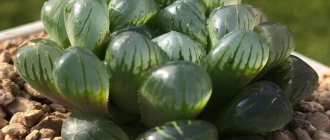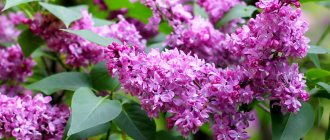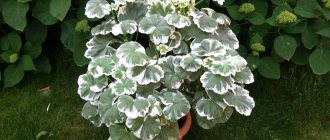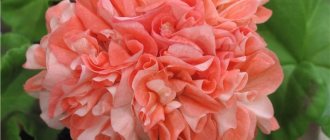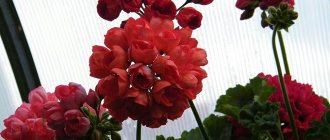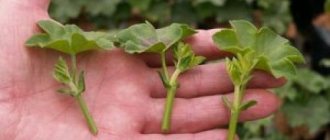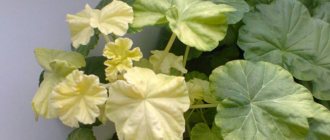Lord Bute
Royal geranium with a very beautiful, velvety dark burgundy tint of inflorescences and pink edging of the petals. The flowers are large, slightly reminiscent of a pansy in shape: the petals are layered on top of each other like a fan.
However, the plant has no odor. The foliage of this species is dense with a jagged edge. Pelargonium reaches a height of 20-30 cm.
This variety is very capricious and fastidious in care. In unsuitable conditions, it can lose all its buds or even die.
You should not expect rapid flowering; it begins in plants that have reached two years of age.
Pelargonium ivy-leaved - ampelous geranium
An excellent material for outdoor vertical gardening of lobbies, verandas, balconies, windows and for indoor use are ivy-shaped pelargoniums, which can currently be purchased in flower shops.
Ivy-leaved pelargoniums. This group includes ampelous (hanging) species with thin branched stems, shiny, smooth, ivy-shaped leaves and beautiful umbrella inflorescences of pink or red tones. Blooms throughout the summer and early autumn. Ivy-leaved pelargonium propagates by green cuttings at any time of the year (preferably in spring). The cultivation and care techniques are the same as for Zonal pelargoniums, so they can be grown together.
We are more or less familiar with the salmon-pink varieties Lahskenigin, Talile, Ville de Paris, purple Amethyst, and pink Holstein. Abroad, where this culture is extremely popular for decorating balconies, terraces, external window boxes, vases, the range is much wider.
It is not surprising that pelargoniums are so loved all over the world. The care and propagation of these plants is very simple. However, among them there is a small group of fragrant pelargoniums, which are grown not for their flowers, but for the aroma of their leaves.
Ardens
This variety of pelargonium blooms with peculiar umbrellas with small, neat and sophisticated red flowers and wine veins on the petals. The leaves are large, rich green.
The flower itself grows quite tall, but the main foliage is in its lower part.
Geranium does best in a semi-dark place. It blooms for a long time, but for more beautiful flowering it needs pruning and shaping of the bush.
Popular varieties of zonal pelargoniums
Most often in home collections you can find several varieties of zonal pelargoniums, which delight with beautiful flowering and unpretentiousness:
- Apple Blossom Rosebud. Rosebud variety, double flowers, white in color, with a pinkish border and a green center. The leaves are simple, green in color;
Pelargonium zonalis Apple Blossom Rosebud
- Red Pandora. Tulip-shaped pelargonium, flowers of complex colors - deep pink-red inside, light red outside, with veins;
Pelargonium zonalis Red Pandora
- Rumba Fire. Medium-sized variety with red, almost luminous inflorescences;
- Bravo Pastel. The color of the petals looks quite unusual - a raspberry-pink center stands out against a white, almost salmon-colored background;
Pelargonium zonalis Bravo Pastel
- Meteor. Bright red flowers with dark longitudinal stripes look impressive against the background of dark green foliage. A low-growing variety that has proven itself well in garden cultivation.
The varieties “Merkur 2000”, “Alba” and “Sharman 98” have long become a kind of classic and are loved by flower growers.
Westdale Appleblossom
The plant blooms very luxuriantly all season with magnificent large caps consisting of many inflorescences. White buds with a soft pink edging resemble small roses.
At the beginning of the growing season, the bushes need to be shaped by pruning the shoots. And when the “roses” begin to gradually fade, they need to be removed, in which case the entire bunch will continue to bloom.
In addition to flowers, pelargonium has very elegant decorative foliage. Each leaf has a dark green center and a white edge.
This species loves diffused light and warmth. The flower is very picky: it does not tolerate dry air and soil, does not tolerate waterlogging and drafts.
The flower should be grown in spacious pots, but not in open ground. In unsuitable conditions it tends to shed its leaves.
Pelargonium zonal: botanical description
Pelargonium zonalis
Zonal pelargonium is a lushly leafy, erect, bushy perennial plant (see photo). The height of adult specimens in natural habitats or open ground can reach 1-1.5 m, however, when grown indoors, the size of the flower is much more compact and rarely exceeds 50-60 cm.
This variety of pelargonium responds well to the formation of a crown - if desired, you can get both a lush bush and a tree with a leafy top. During the growth process, lignification of the lower part of the trunk occurs, and a characteristic rough, light brown crust appears. The green mass is covered with soft fibers; a semicircular yellow, brown or dark green contrasting edging is noticeable on the plates - the “zone”, the presence of which gave the name to this group of pelargoniums. The leaves are most often round, with soft serrated edges and slight dissection.
The leaves are arranged alternately along the trunk and, when touched, emit a characteristic “geranium” aroma. Simple, semi-double or double flowers are collected in spherical inflorescences, which, thanks to long peduncles, rise above the crown of the bush. The color of the petals is varied and varies from the pink and scarlet typical of pelargoniums to white, coral and complex, combining several tones.
Flowering lasts from spring to autumn, but some varieties are capable of laying flower buds all year round. Peduncles form in the leaf axils, and the buds open gradually.
The zone on the leaves is best seen in good, high-quality lighting and disappears in the shade. In addition, by its absence, the condition of the plant can be determined - in diseased specimens the contrasting border often disappears, but is restored after treatment.
A little about the origin
Zonal geranium is a native of the African continent, which came to Europe in the 17th century. The Dutch were the first to cultivate the plant, then pelargonium spread to botanical gardens and private collections in other countries.
As a result of breeding work, which continues to this day, new varieties with unique decorative characteristics are being developed. Unfortunately, active hybridization led to the almost complete loss of the original specimens, but at the same time it made it possible to improve the aesthetics of flowering and obtain a unique leaf color.
Norrland
Zonal geranium with large double flowers of a deep pink hue. Each of the inflorescences is shaped like peonies.
The bush grows quite tall, but needs to be pruned and shaped. Otherwise, strong and long shoots will grow so much that the plant will lose all its beauty.
The leaves themselves are oval in shape. They are painted in a delicate light greenish tint and are soft to the touch.
The variety is quite unpretentious and can be grown in the garden. It is better to plant pelargonium in partial shade, but the soil should be nutritious and rich in microelements.
The best varieties
Let's look at the most popular varieties of dwarf pelargonium.
- Pink Ice. The bush is branched, strong and dense. Double flowers. The petals are quite long, soft pink in color, with a gradual lightening towards the edge. Cases have been recorded when one red flower could appear among the pink ones. Pink Ice is similar in many ways to the Natalie variety, but unlike it does not cause any problems with shaping. May be a little littered with petals.
- Jinky. The flowers are large, double, and form lush caps. The petals are pinkish-peach, sometimes with a cream tint. Closer to the core the color is especially rich. Flowering is long and abundant. The bush is airy and neat. The leaves are golden-green, often with an inner dark circle, giving them a special decorative appearance. Resistant to yellowing.
- Madame Salleron. This variety is valued primarily for its decorative gray-green leaves with a wide creamy-white border. The petioles are thin. The bush is very lush and does not emit the characteristic smell of geraniums. It blooms extremely rarely, with simple bright pink flowers. Bred in 1877
- Silk Moira. The inflorescences are dense, densely double, forming caps. The petals can be apricot or pale salmon. The top ones are usually a little darker. The leaves are golden green. The bush is compact, with short internodes, and grows quickly. Zoning on the leaves is weakly expressed, but in bright sun it can become noticeable.
- Clatterbridge. Pelargonium is a zonal type with a fluffy and dense bush. The flowers are densely double, fiery scarlet, and do not litter with petals. Collected in caps 9–10 cm in diameter. In bright sunshine, the petals acquire a crimson hue over time. Flowering is abundant and long. The leaves are small, the internodes are short.
- Pac Harmony. The flowers are semi-double, quite large (from 5 cm), juicy dark pink, lighter near the core. Owners of this flower unanimously note the early and extremely abundant and long “uncontrollable” flowering. Even a young bush quickly grows a large number of large inflorescences. The variety readily bushes and grows wider than tall. The foliage is scalloped and attractive.
- Deacon Suntan. The flowers are semi-double, bright orange, with a lighter underside and a white center. Collected in dense inflorescences, almost the size of a palm. The caps look especially large compared to the compact bush - according to reviews, sometimes they can even outweigh, causing the pot to fall. Flowering is long. The plant begins to throw out inflorescences at a young age. The shoots grow slowly, the bush sometimes remains at the miniature level (less than 12.5 cm), and not dwarf.
- Dylan Cherone. The flowers are speckled, double, with a pink or lilac-white background and burgundy markings. With plenty of light and fresh air, the shades become more saturated and the specks become brighter. Flowering is abundant, flower stalks are formed from almost every leaf axil.
- Marie Louise. The variety is distinguished by the unusual shape of the flowers: they do not open completely, which is why they resemble tulips. The decorative effect of the flowers is enhanced by the wavy edge. The petals are light peach with a transition to cream, sometimes salmon. There is a light border. The bush grows quite slowly.
- Diana Palmer. Geranium of zonal type. The flowers are semi-double, pastel orange, shaped like carnations. Quite large (4–4.5 cm). Flowering begins early, sometimes barely rooted cuttings are already forming buds. The variety does not bush on its own and requires pinching. The bush is relatively large. Leaves stop growing after flowering begins.
Relevant: Rules for caring for the best varieties of fragrant geraniums
PAC Viva Maria
Zonal geranium with large double pale pink flowers with a bright crimson center at each petal. The medium-sized leaves have a rich green tint.
Pelargonium blooms on the fifteenth day. Blooms profusely while maintaining a neat appearance.
Geranium does not require constant attention. Care is limited to regular watering, spraying, and a properly selected corner in the room. The flower will feel best in the shady part of the room.
In addition, frequent watering is not required, otherwise the roots may begin to rot. It is enough to lightly moisten the soil as soon as it begins to dry out.
Variety of pelargonium species
To navigate the diversity of all species of pelargoniums, they are combined into easily distinguishable sections based on characteristics that are quite obvious even to inexperienced gardeners:
- Pelargonium section is a “visiting” beautiful plant with spreading bushes, woody shoots from below, curly leaves and a very high content of essential oils.
- Section Chorisma is a group of shrubby plants with often semi-succulent stems, long-petiolate simple leaves and few-flowered inflorescences of flowers with very large two upper petals.
- Section Campylia is a group of compact tricolor pelargoniums, semi-ampelous or ampelous, with serrated silver leaves of graceful shape and unusual flowers, in which bright upper petals are combined with white lower ones and a bright eye.
- Section Otidia is a group of succulent, fleshy, thick stem-forming species with fine foliage densely divided into narrow lobes. The white, moth-like flowers seem outlandish.
- Section Hoarea - stemless tuberous plants with a very long dormant period.
- Section Glaucophyllum - creeping species with grayish-blue carved leaves and pink flowers.
- Section Ciconium is a group of evergreen species with entire, simple, palmately lobed leaves and pink-red-purple flowers.
- Section Myrridium – species with single, woody stems and pinnately dissected leaves. Inflorescences are few-flowered, with irregularly shaped flowers.
- Section Cortusina is a succulent species with round, long-petioled, cascading leaves, thickened roots and sparse inflorescences.
- Section Subsucculentia - beautiful subshrubs with succulent, fragile, woody shoots with thorns and beautiful corymbs of 10 flowers.
- Section Magnistipulacea - tuberous pelargoniums with fringed flowers.
- Section Ligularia – species with fleshy stems and leaves.
- Section Poliactium is a beautiful species with pinnately divided leaves and night-scented flowers.
- Section Reniformia is a section of subshrubs with simple leaves and small flowers, valued for its aroma.
- Section Peristera is a section of dwarf, creeping, randomly branched species with small, regular flowers.
- Section Jenkinsonia is a charming tuberous species and subshrub that sheds its leaves before flowering, with pinnate or palmate leaves.
Pelargonium incrassatum (Pelargonium incrassatum). © Katya Kotskaya
Lemon pelargonium (Pelargonium citronellum). © KL Gaffney
Orchid pelargonium (Pelargonium ochroleucum). © jeffs bulbesetpots
Fairy Phlox
A non-double variety of star geranium with soft pink flowers that look like crouching butterflies.
This interesting shape of the petals resembles real phlox, hence the name of the variety, translated from English as “Magic Phlox”.
Each soft pink flower has a darker center and veins on the petals. The leaves are oval, wide with a bright green tint.
The variety is photophilous and not very picky. In order for the plant to bloom magnificently and beautifully, excess shoots should be removed from the bush.
Denise
A zonal geranium that has stunning flowers that range from soft pink at the ends of the petals to white in the middle.
It blooms in large lush caps, and each bud is shaped like a half-opened rose.
The leaves are wide, bright green. The bushes themselves are not very tall, but quite powerful.
This type of pelargonium loves light, so it should be placed on the sunny side. Otherwise, the plant will shed its leaves and stop blooming. Watering is required regularly, but not very abundant.
Caring for specific pelargoniums at home
Caring for pelargoniums classified as species is quite simple. They can forgive mistakes in care, but not excessive watering. These are plants with minimal requirements for which a standard approach will do just fine.
Watering and air humidity
Bush pelargoniums, and even more so tuberous or succulent species, prefer light soil moisture. They tolerate drought much better than waterlogging. The substrate in containers should be allowed to dry in the top layer or in the upper third between waterings. The water after these procedures is drained immediately.
Watering should be adjusted depending on the rate of soil drying and air temperature. For pelargoniums that go through the stage of complete dormancy and shed their leaves, watering is stopped; for the rest, watering is reduced (to light moisture).
None of the pelargonium species require high air humidity. It is better to clean the leaves from dust carefully, with a brush. Spraying, showering and classic wet wiping are unacceptable.
Top dressing and fertilizer composition
For species pelargoniums, fertilizing is carried out only during the period of active growth and flowering. They are content with halved doses of complete mineral fertilizers, which are applied once every 2-3 weeks.
Pruning and formation of species pelargoniums
These procedures should only be carried out on shrub-type plants. They are pruned to maintain compactness and the desired shape of the bush. If there is a strong loss of decorativeness, you can cut the branches quite strongly, down to stumps, or grow replacements from cuttings.
Transplantation, containers and substrate
Plants are replanted only as needed, at the end of February or March, maintaining the same depth level. Soil quality is a key factor in growing pelargonium species.
All species, without exception, prefer a light substrate. Even in special purchased soils, it is better to add loosening additives, up to half the mass (vermiculite, perlite, coarse sand).
Aristatum
Pelargonium has unusual flower caps: each inflorescence is shaped like an umbrella with thin petals. Each is cream or pale yellow in color, with the back two petals flecked with wine color. The leaves are small, oval-shaped and deep green.
This type of pelargonium does not require special care. The plant is light-loving, but will also thrive in partial shade. Does not require frequent watering.
A special category of decorative pelargoniums
Like many ornamental plants that have become super-popular, pelargoniums have almost lost their original face. “Wild” species, which have remained unchanged for thousands of years, have replaced modern varieties and hybrids. But all the more valuable are the almost disappeared relatives of fashionistas.
Species pelargoniums have transformed from “simple” plants over the last half century into collectible rarities. Their fans create entire clubs, and the opportunity to acquire a new look is valued no less than the search for other indoor rarities.
Species pelargonium, or original, wild, natural pelargonium (in the English version - Pelargonium species, Species pelargonium) is a large group of plant species from the genus Pelargonium that have not undergone selection and have retained their natural beauty. In total, there are more than two hundred species in the genus Pelargonium. And they are all decorative.
In nature, almost half of the species of pelargonium are found in Africa, but there are also New Zealand, island, Australian, and eastern endemics. The history of cultivation of pelargoniums from the species group dates back to the 17th century.
Pelargonium species includes herbaceous perennials, annuals, and subshrubs. These are upright and ampelous, spreading and more austere, densely leafy and almost “naked”, mainly aromatic crops.
Some pelargoniums have trunks that store water, others have tuberous thickened roots, others do not form stems, and some conquer hearts with their stems. Not to mention that pelargoniums are not only evergreen.
Pelargonium capitatum. © Frozen Seed Capsules
